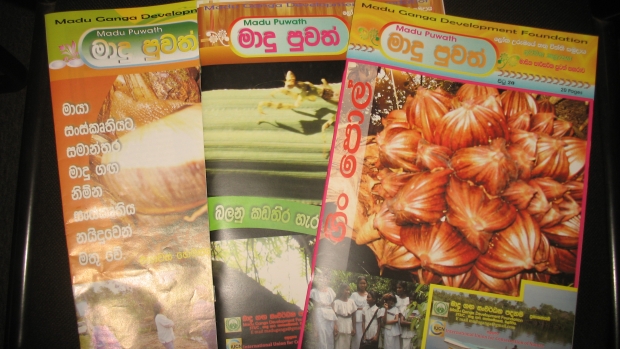Grants :: Small Grant Facilities :: Publishing an environmental magazine, Madupuwath
Publishing an environmental magazine, Madupuwath

Madupuwath magazine , Sri Lanka © KEkaratne , 2009
Objectives
This project had two main objectives: to educate the community living around Maduganga estuary about its environmental values; and to educate schoolchildren in the local community.
Background
The Maduganga estuary and its islands, a complex coastal wetland ecosystem, was declared a Ramsar site in 2003. The 915 hectare estuary consists of 770 hectares of open water and 15 islands that collectively cover 145 hectares. It has several wetland vegetation types, including mangrove forest, mangrove scrub and bank scrub, with a total of 303 plant species in 95 families. Mangroves harbour the greatest number of plant species, closely followed by mangrove mixed swamps.
The threats to the Maduganga wetland are many, chiefly clearing of mangroves, dumping of waste, discharges of fuel from boats, discharges of agro-chemicals, the spread of invasive species, and erosion of river banks. The need to inform local people of the dangers faced by this unique ecosystem, and so reduce the threats, was recognized by the Maduganga Development Foundation (MDF), a pioneering local NGO. With support from government, and later MFF, MDF started spreading the message through an environmental magazine.
Madupuwath is a monthly environmental magazine devoted to the Maduganga wetland. Published in the Sinhala language, the first four issues were printed in 2007 in black and white, with funds from the Coastal Resources Management Project administered by the Coast Conservation Department. MDF secured a small grant from MFF to produce 12 more issues of the magazine, which carries news items and articles on Maduganga area.
The aim of this project was to educate the community around Maduganga, and in particular to educate local schoolchildren and win their cooperation for protecting the remaining unspoilt mangroves in the estuary.
Target beneficiaries
The community living around the Maduganga wetland, and schoolchildren in particular.
Outputs
- Production and distribution of 12 issues of Madupuwath.
- Awareness of environmental issues raised in the community.
Accomplishments and challenges
Over the course of a year, the project published 12 issues of Madupuwath, an environmental magazine targeting schoolchildren with stories and news articles relevant to the Maduganga area. The grant allowed MDF to improve the magazine’s design and layout to make it more attractive, and covered the printing costs of the first three issues. Production of the next nine issues was funded from the sales of previous issues. Issues 5 to 12 were printed in colour in editions of 1,000 copies. They were sold for US$0.26 at local bookshops and schools, and at the MDF office.
Challenges
The project faced a delay in implementation caused by a change of administration, but was eventually able to bring awareness of the importance of conserving mangroves into the school curriculum.
Contributions to cross-cutting themes
Communications and gender equality
The project was entirely in the field of communications, and targeted both men and women, including boys and girls, as producers and readers.
Lessons Learned
A publication can raise community awareness and promote involvement in environmental conservation. However, a market analysis should be carried out before publishing any periodical that depends on sales revenue for its long-term sustainability.
Project Facts
Country
Location
Maduganga, Sri Lanka
Topic
Duration
1st Jan 2009 to 31st Dec 2009
MFF Grant Amount
US$4,386
Implementing Partner
Maduganga Development
Foundation (MDF)
373C Galle Road, Pathegamgoda, Balapitiya, Sri Lanka
Tel: +94 77 9714278
